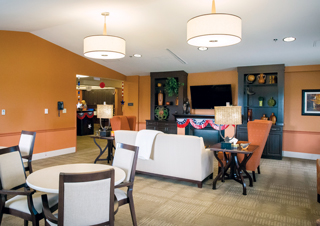
Not that long ago, lighting was a big architectural afterthought in eldercare facilities. Today, it has become as integral a design element as windows, doors, furnishings, flooring and woodwork.
In fact, thanks to years of evidence-based research on its impact on health, lighting has taken center stage for its ability to manipulate and illuminate. At the flick of a switch, appropriate and well-conceived lighting can meld other aspects of spaces to create complete harmony.
Shedding light
Few aspects of senior living’s physical environment face more scrutiny than lighting.
Poor and inappropriate lighting haunted nursing homes for years. Even now, some facilities have a fraction of the lighting levels recommended by the Illuminating Engineering Society, observes Rodney Smith, chief technology officer for uSave LED. Moreover, an abundance of table and floor lamps and even recessed ceiling “can” lighting might create shadows and glare issues, he adds.
Inappropriate lighting also has been a culprit for everything from poor staff productivity and resident falls to chronic depression. A recent Danish study showed simple tweaks like infusing more blue light in a rehab facility mitigated depression in stroke victims.
Indeed, fluorescent lighting has become synonymous with miasma.
“Gone are the days of recessed fluorescent troffers in a sea of acoustical ceiling,” says Karla Jackson, design director at studioSIX5 in Austin, TX.
Adds Jim McLain, general manager of CS Eldercare Interiors: “Traditional fluorescent lighting mounted in the ceiling and behind resident room beds often provide insufficient luminescence for the resident looking to read or perform other activities, while producing a negative effect of this lighting spilling over into adjoining resident space, disrupting their visual privacy and interfering with sleep habits.”
Without doubt, research into the effects it has on the brain and our biorhythms has done more to shape lighting than anything else.
The crux of the problem is blue light at the wrong time. In layman’s terms, natural sunlight contains heavy doses of it. Unfortunately, so do bright fluorescent fixtures, computers, televisions and mobile phones. When the brain is exposed to too much blue light at night, it is tricked into thinking it’s time to wake, inflating cortisol levels and disrupting its production of melatonin, which regulates the sleep cycles.
Exposure to blue light at night has been linked to Sundowners Syndrome, and a host of harmful health issues such as seizures.
With incandescent fixtures now bordering extinction, LEDs are rapidly becoming the lighting of choice in eldercare.
“Almost all communities are electing to use LED lighting now in lieu of fluorescent and incandescent lamping of the past,” says Jackson. “It is significantly more energy efficient, has better color rendition (3000-3500Kelvin is optimal) and costs have come down considerably in the past few years due to increased demand and availability.” (The temperature of lighting is measured in Kelvin, or “K,” degrees.)
Boca Raton-based USave LED captured the wave early after extensive research on lighting and circadian rhythm. Its WalaLight™ (named after “Wala,” the aboriginal goddess of light) is a modern LED lighting technology that simulates sunshine (6500K) in the morning while having the ability to self-adjust over the course of the day to night light levels (2200K) in the evening.
“Circadian rhythm lighting seeks to mimic natural daylight conditions and promotes wellness,” says Smith, who invented USave LED’s WalaLight product line. It’s also been identified by the National Institute of Health as important to wellness, affecting the rate of healing for hospitalized patients, and is a factor in reducing falls. Circadian rhythm lighting also has been linked to positive therapeutic treatment of Sundowners Syndrome.
In one pilot study at ACC Care Center in Sacramento, residents experienced less agitated behaviors and had a significant reduction in psychotropic medications after the center upgraded. It replaced fluorescent lighting with LEDs in a corridor, two residents’ rooms, a nurse station, a family room and the administrator’s office.
While the study was small, the “results seem to validate many emerging hypotheses about both natural and electric lighting’s ability to have vital impacts in healthcare facilities,” according to National Lighting Bureau Chairman David R. Errigo.
Memory care benefits
It didn’t take a great leap to understand how lighting could affect the brains of seniors suffering from dementia. Back in 2014, researchers installed so-called “blue-white” lights in the rooms of 14 dementia patients and found measurable reductions in their levels of agitation and depression, as well as improved sleep duration and quality. Recently, researchers found sunlight-deprived Alzheimer’s residents’ brains lit up when staring at so-called “light tables.”
“One contributor to limiting visual acuity is Alzheimer’s disease,” says Melinda Ávila-Torio, CHID, RID, CASP, LEED® AP, associate and managing interior designer at THW Design. “It has been determined that the aging eye requires 30% more illumination than the normal eye.”
Ávila-Torio promotes “tunable” LED lighting, which was used in the Sacramento study, and notes that facilities with memory care residents should employ lighting schemes that mimic what residents had in their own homes.
Anna Chaney, lead contract designer at Flexsteel, agrees.
“Understanding that some memory care wings are working with color-identification to help residents identify their living spaces, lighting can help enhance the effort,” she says. “If a certain color is identified with a specific area, the lighting can really affect the hue in which a specific fabric is chosen. The lighting and furniture need to work together to help ensure an obvious match to the color designated for an area.”
Tinted views
Easily overlooked aspects of lighting include wall coverings and paint.
A room must have “uniform ambient light levels, along with a good distribution of daylight,” explains Emily Kantz, interior designer, color marketing and design, for Sherwin-Williams. “When choosing colors, it’s important to select them for the room in which they will be painted, and check the final selections at different parts of the day because the color may slightly change as the day progresses.”
Dark colors gobble up light. That’s why designers prefer warmer, lighter hues in matte finishes, especially in senior living areas. For dementia residents, it’s helpful to paint rooms in contrasting colors so they can easily tell them apart, Kantz says. Bathe quiet areas in light blues and stimulating areas in green, for example.
Electric loads
Paint saturation and hues can either absorb or reflect light in some unpredictable ways.
Jackson notes that in levels of care with higher acuity, there are code-required minimum foot-candle levels for all spaces, which often conflict with local energy codes. This is why designers take great pains to consider design elements holistically to maximize light levels without adding fixtures and increasing energy loads.
“Darker paints definitely create a more dramatic mood, but must be balanced with adequate, well-placed lighting,” she adds. Careful attention must also be paid to the colors of paints on walls near sunlight. “It takes longer for an aging eye to adjust to a significant contrast between a window and a dark wall.”
Another technical matter is the light reflectance value of paints, says Ávila-Torio.
“The LRV should be considered if the intent is to keep as much of the artificial lighting illumination within the space,” she notes.“If it is, highly saturated paint colors should be used. Paint tones are the first indicator on how successful the lighting coloration and lamping type selected have been implemented.”
Kelvin temperature is an important factor in the appearance of surfaces and is the primary external variable in how fabrics, flooring material, and wall coverings appear, says Smith. LED lights are known for reducing glare, and brighter lights better highlight contrasts in fabrics.
Jackson painstakingly tends to ambient lighting in her designs.
“We look for decorative fixtures that provide a soft, diffuse light and ensure that the actual lamps themselves aren’t visible, creating hot spots or glare,” she says. “Task lighting is also crucial, putting an increased light level directly on a task area, like under-cabinet lighting in kitchens and pendants or desk lamps at work areas.” Comparatively, accent lighting can highlight art work or aid in wayfinding, she says.
This makes color choices all the more critical, adds Nick Alexandropoulos, marketing communications specialist for ALTRO.
“Color choice affects both mood and wayfinding in senior living environments,” he says. “For example, reds release adrenaline, blues lower blood pressure and neutral colors are restful and noninvasive. Contrasting colors can help create a path, point out important objects in a room such as a sink in a bathroom and reduce the chance of trips and falls.”
Because spatial issues are common in older people Alexandropoulos advises strong contrast between the colors of floors and adjacent walls and floors.
Creating spatial harmony
Designers speak of light as a way to “pull it all together.” The type of lighting often dictates where furnishings are placed.
“If it’s for a public area or somewhere with lots of natural light, we find designers select different fabrics than they would if the piece was located in a resident room or somewhere with more synthetic light,” says Chaney. “Bright and warmer fabrics and patterns usually play out better in the synthetic lighting environment, and can bring in the warmth that sometimes lacks when natural light isn’t the primary source.”
Let the sun shine in
No respectable designer, scientist, researcher or clinician can dispute the body of evidence around sunlight.
“Obviously, nothing can truly replace the benefits of natural light,” says Melinda Ávila-Torio, CHID, RID, CASP, LEED® AP, associate and managing interior designer at THW Design. “It is the only light source the human body can metabolize.”
“Humans tend to feel better when in the presence of nature or natural looking materials. This includes natural light,” adds Nick Alexandropoulos, marketing communications specialist for ALTRO. “Especially evident in healthcare, biophilic designs have shown to improve people’s moods and productivity, and even help with the healing process.”
Some even believe artificial lighting is actually making people sick. In a study published in the journal Current Biology, researchers linked long-term exposure with common issues of the frail elderly: pro-inflammatory activation of the immune system, muscle loss, and early signs of osteoporosis.
“Natural light can be beneficial for senior living residents, and seniors can be seen clustering in centers near where natural light is penetrating the building,” observes Rodney Smith, chief technology officer of uSaveLED. “An innovative way to deliver it is through design that includes a secured courtyard area where residents can safely go and be exposed to natural daylight.”
Karla Jackson, design director at Austin, TX-based studioSIX5, is a strong advocate for incorporating natural light whenever possible. “Seniors, like younger people, are drawn to the light, warmth and views that only a window can provide,” she says.
But there are some important caveats.
Natural lighting can be expensive to deliver architecturally, and can be challenging in locations having greater variance in daylight through the year, says Smith. Care also must be given to avoid over-exposing seniors’ sensitive eyes to direct sunlight.
For obvious reasons, smartly designed spaces rarely have windows at the end of dimly lit hallways, says Jackson, who advises facilities incorporate sunlight controls such as blinds, shades and sheers to mitigate heat gain and glare and reduce risks of falls.
Moreover, ensure residents who are returning from areas bathed in natural light to sit quietly for at least 10 minutes so their eyes can adjust slowly to the indoors, says Ávila-Torio.
From the May 01, 2017 Issue of McKnight's Long-Term Care News





